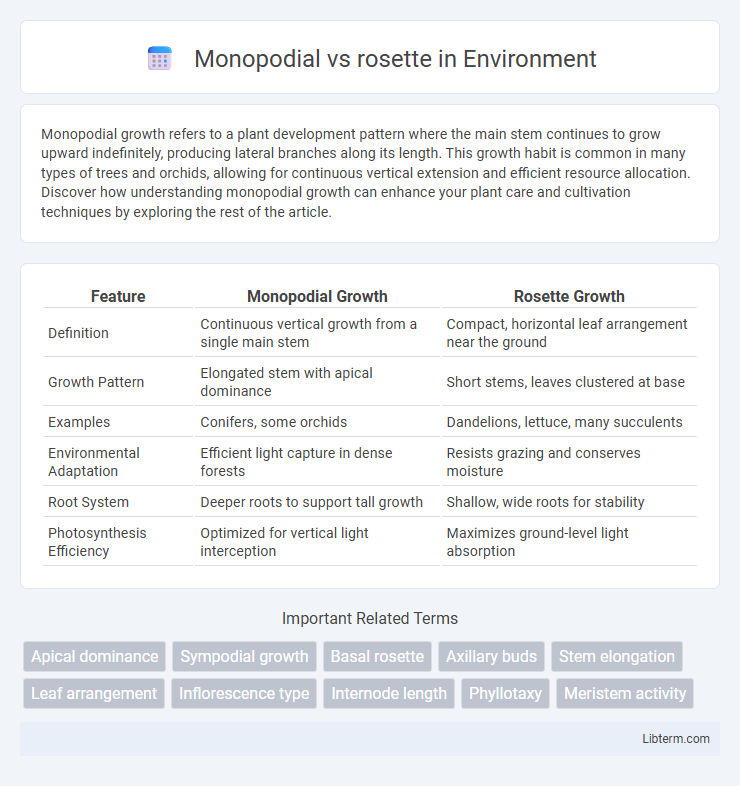Monopodial growth refers to a plant development pattern where the main stem continues to grow upward indefinitely, producing lateral branches along its length. This growth habit is common in many types of trees and orchids, allowing for continuous vertical extension and efficient resource allocation. Discover how understanding monopodial growth can enhance your plant care and cultivation techniques by exploring the rest of the article.
Table of Comparison
| Feature | Monopodial Growth | Rosette Growth |
|---|---|---|
| Definition | Continuous vertical growth from a single main stem | Compact, horizontal leaf arrangement near the ground |
| Growth Pattern | Elongated stem with apical dominance | Short stems, leaves clustered at base |
| Examples | Conifers, some orchids | Dandelions, lettuce, many succulents |
| Environmental Adaptation | Efficient light capture in dense forests | Resists grazing and conserves moisture |
| Root System | Deeper roots to support tall growth | Shallow, wide roots for stability |
| Photosynthesis Efficiency | Optimized for vertical light interception | Maximizes ground-level light absorption |
Introduction to Plant Growth Forms
Monopodial growth forms feature a single main stem that grows continuously from a terminal bud, producing leaves and branches along its length, which is typical in many trees and vines. In contrast, rosette growth forms display a compact arrangement of leaves radiating from a short stem or base, commonly seen in plants adapted to harsh environments like succulents and alpine species. Understanding the differences between monopodial and rosette growth patterns is crucial for identifying plant species and their ecological adaptations.
Understanding Monopodial Growth
Monopodial growth refers to a plant growth pattern where a single main stem continuously extends vertically, producing leaves and flowers along its length without branching extensively. This growth habit is typically seen in orchids, such as Phalaenopsis, where the apical meristem remains active and dominant. Understanding monopodial growth is essential for effective cultivation and pruning techniques, ensuring optimal light exposure and healthy development.
Exploring Rosette Growth Patterns
Rosette growth patterns exhibit a compact arrangement of leaves radiating from a central point close to the ground, maximizing light capture and minimizing water loss in arid environments. Unlike monopodial growth, where a single main stem elongates vertically, rosette plants develop a basal cluster allowing efficient nutrient storage and protection from herbivores. This morphology supports survival strategies in various habitats by optimizing photosynthesis and growth under environmental stress.
Morphological Differences Between Monopodial and Rosette
Monopodial plants exhibit a single, dominant vertical stem that grows continuously from the apex, characterized by elongated internodes and leaves arranged alternately along the stem. Rosette plants, by contrast, display a compact, low-growing structure with short internodes and leaves clustered tightly at the base, forming a circular shape. This fundamental morphological difference impacts their growth habits, resource allocation, and adaptation strategies in various environments.
Key Examples of Monopodial Plants
Monopodial plants, characterized by a single, continuously growing main stem, include key examples such as orchids like Phalaenopsis, which exhibit vertical growth with leaves and flowers developing along the stem. Other notable monopodial plants are bamboo species that grow upward through a dominant central shoot, allowing tall, unbranched stems. This growth pattern contrasts with rosette plants, which form dense, circular leaf clusters at the base without a central stem extension.
Common Rosette-Forming Species
Common rosette-forming species such as dandelions (Taraxacum officinale), lettuce (Lactuca sativa), and plantains (Plantago major) exhibit a circular, ground-level leaf arrangement that maximizes sunlight capture and reduces water loss. Unlike monopodial growth, characterized by a single dominant stem as seen in bamboo (Bambusoideae) or orchids (Orchidaceae), rosette plants concentrate nutrient storage and growth in the base, promoting resilience in harsh environments. Rosette formations enhance protection against herbivory and support efficient nutrient cycling, making them prevalent in diverse ecosystems worldwide.
Ecological Adaptations of Monopodial vs. Rosette Plants
Monopodial plants exhibit vertical growth with a single dominant stem, allowing them to efficiently access light in crowded environments, which is advantageous in dense forests or tall grasslands. Rosette plants grow with leaves arranged in a circular pattern close to the ground, minimizing water loss and protecting meristematic tissue from herbivory and harsh climatic conditions, often found in arid or alpine habitats. These structural adaptations enable monopodial species to thrive in competitive vertical niches, while rosette plants optimize survival in stress-prone, low-resource environments.
Advantages and Disadvantages of Each Growth Form
Monopodial growth exhibits continuous vertical stem elongation, enabling plants like orchids to access higher light levels and improve air circulation, though it requires stable support structures and may be more susceptible to wind damage. Rosette growth concentrates leaves in a basal cluster, maximizing ground-level photosynthesis and water conservation, but limits vertical expansion and dispersion, potentially reducing competitive shading ability. Each form offers adaptive strategies: monopodial growth favors height and resource capture above competitors, while rosette growth enhances survival in resource-poor or exposed environments.
Monopodial and Rosette in Horticulture and Agriculture
Monopodial growth in horticulture refers to plants that grow vertically from a single main stem with continuous upward growth, common in orchids and some trees like pine, allowing for efficient light capture and space utilization. Rosette growth involves plants developing a circular cluster of leaves at the base with minimal vertical elongation, often seen in crops like lettuce and cabbage, which aids in weed suppression and moisture retention. Understanding monopodial versus rosette growth habits informs crop management and selection strategies to optimize yield and spatial arrangement in agricultural systems.
Conclusion: Choosing the Right Growth Form for Your Garden
Choosing between monopodial and rosette growth forms depends on garden space and aesthetic preferences, as monopodial plants grow vertically with a single main stem, ideal for limited spaces, while rosette plants expand outward horizontally, creating dense, ground-level coverage. Monopodial forms offer easier access for maintenance and blooming, whereas rosettes provide better protection against soil erosion and retain moisture efficiently. Understanding these growth habits ensures optimal plant health and garden design tailored to environmental conditions and horticultural goals.
Monopodial Infographic

 libterm.com
libterm.com